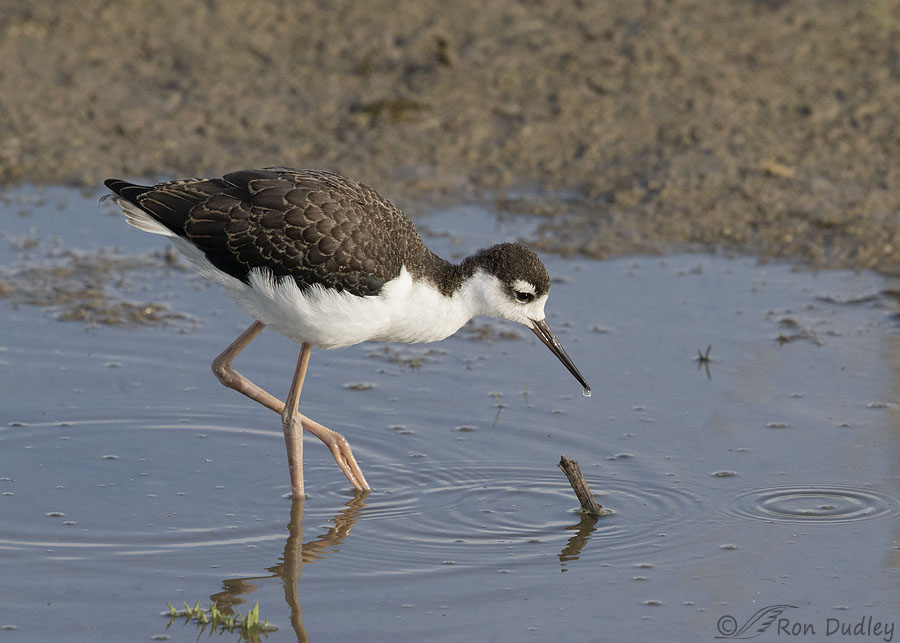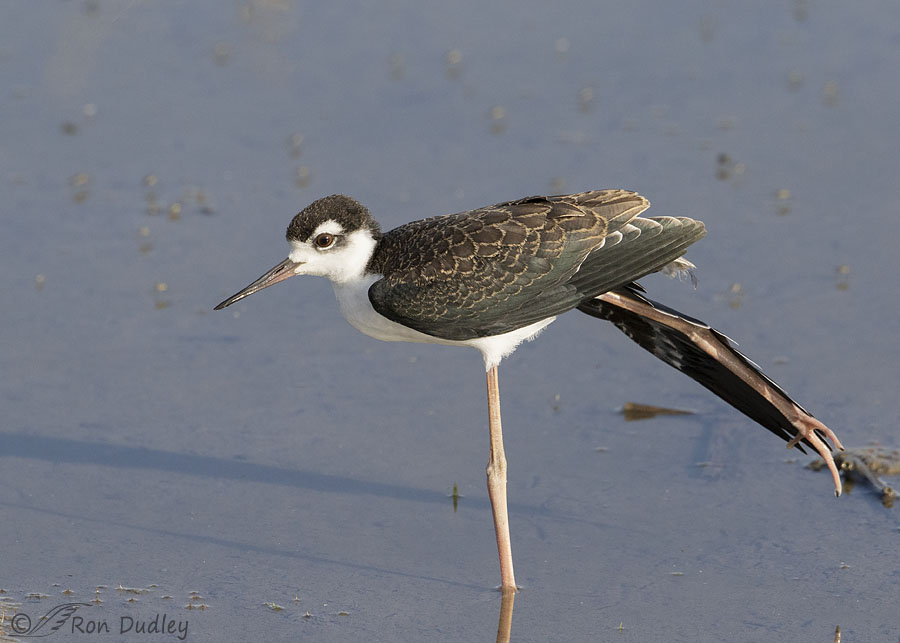Plus an image-leveling tip for beginning photographers.
1/2000, f/6.3, ISO 800, Canon 7D Mark II, Canon EF 500mm f/4L IS II USM + EF 1.4 III Extender, not baited, set up or called in
A week ago today I photographed this juvenile Black-necked Stilt performing a wing and leg stretch at Bear River MBR. It was a slow, languid stretch so I got many photos of it and in all of them the bird kept its leg tucked under the extended wing as if it was trying to prevent a sunburned leg.
Even though the plumage patterns of young juveniles like this are similar to those of adults the immature birds are easily distinguished from adults because the dark feathers of their upperparts have buff-brown margins, creating a scalloped effect that the adults lack.
- Tip for beginning photographers: A photo like this can be difficult to level accurately during processing because there are few cues in the image to indicate true level (there’s no horizon for example). In this case I used the tip of the longest toe on the right foot and the reflection of that same toe that can barely be seen in the bottom right corner of the image. A straight line drawn between the two should be perfectly vertical. It wasn’t in the original image so I leveled it (the steps involved in actually leveling an image depend on what processing software you’re using).

1/2000, f/6.3, ISO 800, Canon 7D Mark II, Canon EF 500mm f/4L IS II USM + EF 1.4 III Extender, not baited, set up or called in
Here’s the same bird foraging for food in some of the very little water available this year in that part of the refuge. While I was processing this photo and paying attention to detail the more time I spent on the process the more I liked the image, even though the photo didn’t jump out at me at first. Here’s some of the details that appeal to me:
- The angled light on the dorsal darks really highlights the scalloping of the feather edges of the juvenile.
- The setting may not be beautiful but it’s typical feeding habitat for the species and that always appeals to me. I like the sprigs of emerging green vegetation at bottom left and I even think the stick below the bird’s bill adds to the image.
- I enjoy the raised-foot pose and the water drop clinging to the bill.
- With the whites and near-blacks of the bird in full sun this was a difficult exposure and I think I nailed it.
- But more than anything I like the series of circular water disturbances that decrease in size from left to right in the direction the bird is looking and traveling. To me they almost seem as if they’re pointing the way for both the bird’s direction of travel and the viewer’s eye as it passes over the image.
Ok, enough personal image analysis on my part. Each viewer will have their own opinion and for some the image may seem pretty pedestrian and that’s perfectly fine. But I’m not one of them.
Ron



Lots of juvenile shorebird juveniles have that scalloped effect on their dorsal feathers until the edges wear off.
I really like the focus the young bird has on what it’s hunting in the second photo in addition to your likes.
Great photographs of the juvenile stilt! I love both shots. The plumage is wonderfully detailed and I really like the drop of water on the end of the beak in the second image. Good tip on leveling. It’s MUCH easier to get it right in the field than mess around with leveling on the computer where you’ll invariably lose a portion of your composition.
Coincidentally, I spent the day at a large wetland area where (surprise!), I found juvenile Black-necked Stilts to photograph! Hope the results are half the quality you have achieved here!
“It’s MUCH easier to get it right in the field than mess around with leveling on the computer where you’ll invariably lose a portion of your composition”
You make a valid point, Wally. However, what you suggest often doesn’t fit my style of shooting. I’m basically hand holding my lens and since I love photographing behaviors involving fast-moving birds it’s very easy for me to tilt my camera a little while I’m following them. If I take the time to pay much attention to “level” while I’m shooting it means I’m missing opportunities. So I’d rather get the shot and then correct for level if necessary and possible but as you mention that means you lose part of the image so it definitely can get tricky.
But you’re right. It’s definitely much easier to get it right in the field. If you can…
And, of course, I should of included a qualifier something like “if you have a chance”, get it right in the field. Very often that’s not an option! Shoot first, level later.
Lovely shots, Ron – love the scalloped effect of the feathers and also love the way the rings of water decrease in size in effect pointing the way the bird is going…… 🙂 Thx for the tips on leveling – it is a REAL challenge at times…… 😉 The way the bird in the 2nd photo is looking down gives a softer look to it’s face. Late today – one of those hour or 2 projects that end up taking all day…..sighhhhhhh 😉
Thanks, Judy. I was wondering where you were… 🙂
The first shot is so neat, with the wing sheltering the leg. So interesting. I also like the way the right-most water ripple seems to be beckoning the bird forward.
Thank you, Marty.
I have never seen this bird close up. What a beauty. Thanks Ron!
They’re a striking species, Jean – both adults and juvies.
Gorgeous photos! I love the natural habitat around the bird – to me it’s perfect. I’ve never seen a juvenile before, they are so beautiful. Thanks
Thanks very much, Joanne.
Love those scallops.
Juveniles (of species other than our own) are so often gorgeous. My jury is out on our own species.
I like’em too, EC.
Don’t mind the critique it is always interesting why the photographer likes a particular photo and the thoughts behind the lens.
I think I would have leveled the vertical leg more for my taste but then I am a novice and I still play around a lot with my leveling. I have photos that perplex me often which plane should I straighten for? I know I always tend to have a 1 to 2 % tilt to the right in all my photos, but sometimes the eye catching lines are what dictates how much I level.
“I think I would have leveled the vertical leg”
April, a lot of folks would instinctively use that leg as a guide to true vertical but the problem is that it isn’t vertical. The center of gravity of the bird isn’t directly over the leg (especially with this pose) so the leg is tilted off vertical so the bird can maintain its balance.
Not sure I completely understand the leveling thing, but it certainly works for the first image. I see a very pleasing green tinge on the primaries and secondaries in the first image. I wonder if that is a true color or one of those reflection/iridescence things.
Lots of interesting details in the second photo, as you point out. I also like the fluff of white flank feathers covering the bottom edge of flight feathers which is different than the first image.
Lyle, I actually leveled the second image too. If I remember correctly I used the left edge of the twig sticking out of the water with the reflection of that same edge in the water as quides.
Both are beautiful photos…you captured the moment perfectly! ❤️ I agree totally with Everett…all juveniles are ‘so cute’. The scalloping is perfect and I find the rich brown head feathers seem to give a modified ‘brush-cut’ look to these juvies…so cute! 😍 On another note…nothing seems to spoil a picture more than it presenting an uneven keel. I believe it is the first thing that catches my eye.
“I believe it is the first thing that catches my eye”
I strongly agree, Kathy. When an image has an obvious tilt it’s about all that my eye sees. I just can’t look past it.
This is delightful. I’ve seen adults in the spring as they migrate through, but never any young. The scalloping effect is pretty, even though the sleek black and white of the adults special too.
Nancy, when the light isn’t good juvies and adults can look very similar. But with good light on them their differences really stand out.
The rhythm and beauty of the simple things in life, I’ll take it every time and this is a great example.
Thanks for the tip on leveling via the plumb line!
Wonderfull shot.
I’m glad you appreciated the leveling tip, Dave. Just a little thing but it can make a big positive difference.
I always appreciate and enjoy the photography tips just as much as the actual photos. Thank you, from a beginner!
I’m delighted to hear that, Shawna. Thank you.
Really like the scalloped look and the the water drop on the bill. You really did nail it on the light especially the first shot. The colors are perfect as is the catch eye. Good job. And just in general all juveniles just seem to be so cute.
Thanks on all counts, Everett.